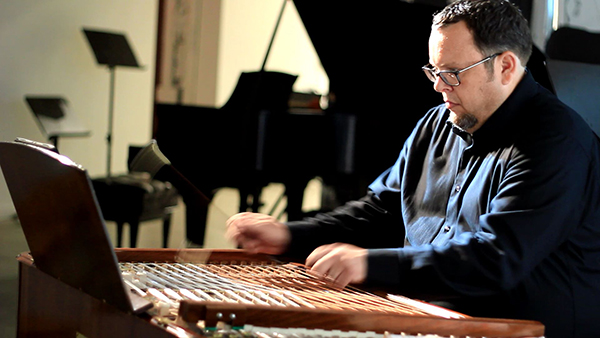by Jacob Strauss

On April 29th at SPACES gallery in Hingetown, No Exit’s program gave the audience music of total anxiety and horror, melancholic hope, and of life’s long continuity without much meaning.
The cimbalom was the feature of the show, an instrument capable of taking on many personas. Its performer, Chester Englander, has shaped his career around the instrument, and has inspired composers to write more repertoire for it, some of which was presented on the program.
Cleveland residents might be familiar with the cimbalom’s sound from hearing it at Hungarian and other Central and Eastern European festivals and restaurants that populate our city. Others might be familiar with its sound and construction thanks to its sibling, the hammered dulcimer.
The show opened with a world premiere of Hong-Da Chin’s “…tears…yet far yet near,” conducted by James Praznik. The piece takes its title from a Gu Cheng poem titled “A Walk in the Rain.” Gu wrote in China in the latter half of the twentieth century, and his experimental poetry was a reaction to the Cultural Revolution and its restrictions on artistic expression.
In the context of No Exit’s entire ensemble, the cimbalom dresses in the sounds of a mandolin, a horn section, and a guzheng. Motifs are first played quickly and boisterously, and then deconstructed, dominant notes hollowed out with harmonics or sustains. Dissonant wailings become sad melodies and melodies become ghosts.
This evokes the images of dams being built in Jia Zhangke’s 2006 film, Still Life, when China’s rapid industrialization began pushing people from their homes, drowning entire villages in the valleys and changing the cultural, as well as the physical landscape. Since Hong-Da Chin’s expatriation to the West, he feels both the proximity of the initial memory, and the disquiet caused by its factual inaccuracies. This composing and decomposing of his reflections is anxiously written into the score, and performed with mathematical precision by Englander and the ensemble.
Traveling to the Nordic state of mind, Per Nørgård’s String Quartet No. 8, Night Descending, inspired by poems written by Guillaume Apollinaire — who was wounded in The Great War and succumbed to the Spanish Flu of 1918 — was bleak and ethereal. Violinists Mari Sato and Cara Tweed, violist James Rhodes, and cellist Nicholas Diodore were able to bring out the horror and graphic nature of the music.
Haunting muted chords ascend and descend, bending in and out of tune before the cradle of soft dynamics is thrown into a loud realization of violence at the end of the opening “Prologue – Eulogy.” “Man – Animal” begins with pizzicato and continues with a demented theatricality, like a Hollywood musical dance number skipping through a devastated city. Voices sing out briefly. Then the descent, the void. Nørgård evokes the first instance of pure sadness at the end of the third movement, “Voyage,” moving into the slow and quiet nightmare of “Night Descending.”
Every small movement arrives as a slice of bow across the strings or snap of strings against the fingerboard, finishing with a groaning cello. The work’s opening theme returns as bombs fall, scattering debris depicted by col legno. The music sinks back into safety with head in hands, only wanting peace and rest and a peaceful dying breath. With musicality and sensitivity, the ensemble concluded the piece with quiet, heartbreaking phrasing.
The audience was given a reprieve from the horrors of the world with an intermission and Edward Smalldone’s Duke Re-dux, an homage to Duke Ellington’s, Come Sunday. A quartet with vibraphone, flute, cello, and bass clarinet evoked images of a calm Sunday morning in New York. Trains rolled underfoot from Gunnar Owen Hirthe’s bass clarinet, the light bounced off the buildings from Luke Rinderknecht’s vibraphone, and the sweet dialogue between Sean Gabriel’s flute and Diodore’s cello sang with a colorful melancholy, like the walk home from church when you are glad to be free from obligation, but too tired to care about any activity for the rest of the day.
The last piece on the program was a new composition for cimbalom and string quartet by Douglas Knehans — who was in attendance — titled Ecstatic Waves. Englander played the cimbalom with both hammers and hands, which lent two different textures to the sound of the instrument.
In “Searise Breaking,” the waves are endless, their constant motion provoking anxiety and dread, but especially in the more violent second movement titled “Enfoamed Rock.” Englander drove the music forward with unrelenting pace, hammering away at the strings, the string quartet mirroring him. The final movement, “Unreturning Tides,” is a slow funeral service, a long elegy full of silences and continuations.
This was not an easy concert to digest. Themes were confrontational and the music was challenging. However, it offered an understanding of how the world sounds harsh and violent and cold, though not always, and not completely.
Published on ClevelandClassical.com May 18, 2022
Click here for a printable copy of this article



